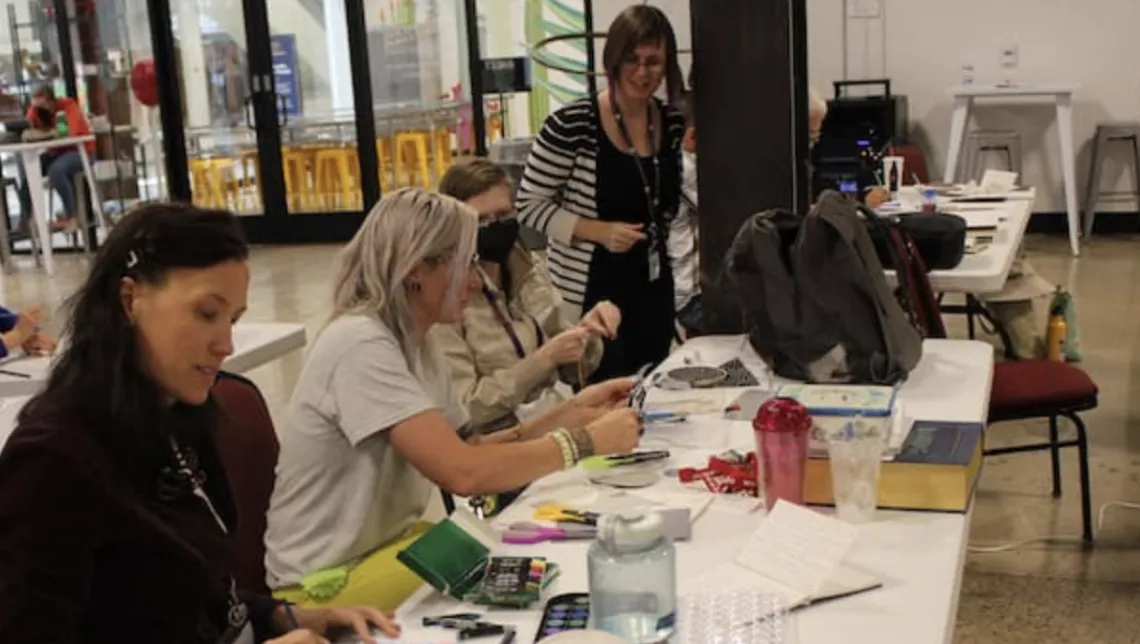LPL alum Jamie Molaro named 2024 Sagan Medal winner for outstanding public communication

Jamie Molaro leads a workshop in which participants translate scientific data and concepts into pieces of art. Credit: Alan Fischer/PSI.
Planetary Science Institute Press Release
The Division for Planetary Sciences of the American Astronomical Society awarded Jamie Molaro, a Planetary Science Institute research scientist, the 2024 Carl Sagan Medal for outstanding communication by an active planetary scientist to the public.
The award recognizes Molaro’s contributions to changing the way planetary science appears to the world, including efforts to connect art and science, and efforts to engage underserved communities.

As a graduate student in 2013, Molaro established The Art of Planetary Science, an annual exhibition which invites the public to engage with science-driven art. She extended this effort into a series of workshops on space, art and society called Making Space, where participants learn how to use art as a tool for scientific inquiry and public discourse around space exploration.
Molaro also formed the Disabled for Accessibility in Space, or DAIS, group to make science more accessible to Disabled individuals. She also leads research with AstroAccess, a project promoting inclusive human space exploration. Molaro’s other outreach activities include public interviews and presentations, and an appearance at Burning Man with an open-source rover.
“I’ve been doing outreach work for over a decade, and it feels good to be recognized and to know that the work that I’m doing is valued by the scientific community and to know it’s having an impact on people,” Molaro said.
The medal’s first winner was PSI’s Senior Scientist Emeritus William K. Hartmann in 1998. PSI alumnus Henry Throop also won in 2017.
“It is wonderful that Jamie Molaro is being recognized for her years of commitment to using art as a means of exploring scientific concepts and humanity’s relationship to space and the purpose and value of exploration and science,” said PSI Director Mark Sykes. “Combined with her networking and support for Disabled space professionals, Jamie is expanding the accessibility of space intellectually and practically for everyone.”
Molaro received her doctorate from the University of Arizona in 2015, then became a NASA postdoctoral program fellow at NASA’s Jet Propulsion Laboratory. Molaro is a former participating scientist on NASA’s OSIRIS-REx mission and current member of the sample science team, as well as a co-investigator for Project ESPRESSO, short for Exploration Science Pathfinder Research for Enhancing Solar System Observations, through NASA’s Solar System Exploration Research Virtual Institute, or SSERVI.
She studies how heating and cooling breaks down rocks and boulders over time. In 2019, she did what she considers some of her most important work with OSIRIS-REx when she discovered evidence that heating of the asteroid’s boulders from the Sun was causing them to fracture and eject debris into space.
Molaro said she’s always been a creative person and had been exposed to the work of space artists like fellow PSI colleague Hartmann. So when, as a graduate student, she was encouraged to develop outreach events, she thought up The Art of Planetary Science.
Timothy Swindle, who directed the University of Arizona Lunar and Planetary Laboratory when Molaro was a graduate student in the department, nominated her for the award. He is now director of the Arizona Space Grant Consortium.
“Dr. Molaro has changed the way that planetary science fundamentally looks,” Swindle said. “The changes are both literal – emphasizing the beauty in science and making art shows, both stand-alone and at conferences, a regular part of the field – and figurative, engaging communities like the Disabled, who have never been brought in before. In particular, Dr. Molaro has invited the public into the production of science in a variety of ways.”
Some of Molaro’s own art is created using layers of paper to depict topographic data from different worlds using spacecraft images.
“I find science beautiful and to know that other people feel alienated by it makes me want to show them what I see,” Molaro said. “I want to show scientific ideas and data in a way that people can connect to without having to know how to study or analyze them in the traditional sense.”
She also said it’s important to do outreach in general, not just so people understand the nitty gritty of geologic processes, for example, but also to encourage them to value science since it has such a direct impact on their lives.
“As an artist I’ve always felt alienated by science even though I was interested in it,” said Violet Brand, a workshop participant. “But now I feel like [Jamie Molaro has] broken down barriers that I had put up for myself, and I can interact with the world in a completely new way.”
Only a few weeks ago, SSERVI awarded Molaro the 2024 Susan Mahan Niebur Early Career Award. She has received numerous other awards and honors, including the NASA Planetary Science Early Career Award in 2023 and the naming of Asteroid 30379 Molaro by the International Astronomical Union in 2021.

